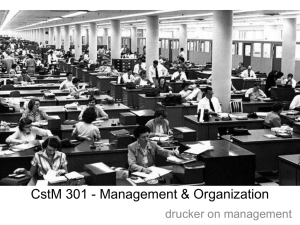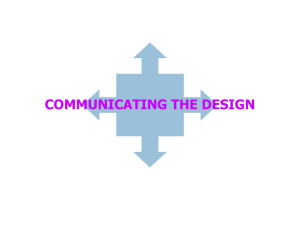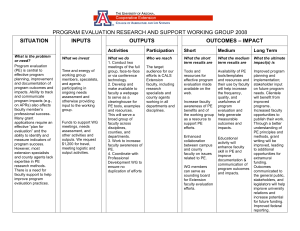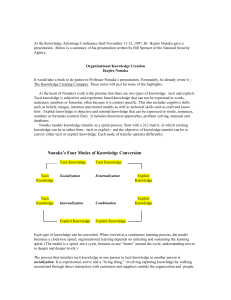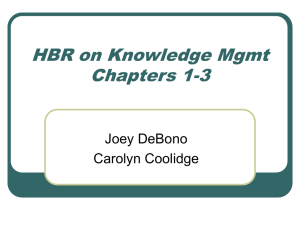Harvard Business Review Knowledge Management ON Yan An
advertisement
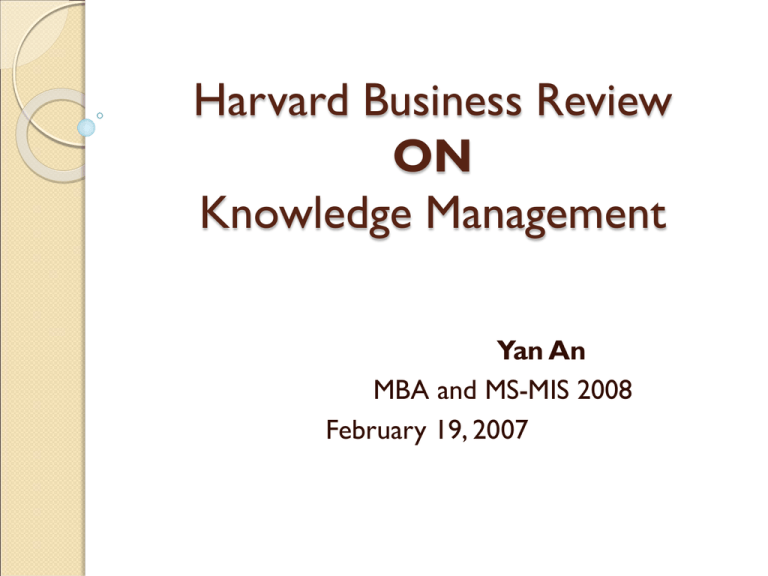
Harvard Business Review ON Knowledge Management Yan An MBA and MS-MIS 2008 February 19, 2007 Today's Agenda The Coming of the New Organization ◦ By Peter F. Drucker The Knowledge-Creating Company ◦ By Ikujiro Nonaka Building a Learning Organization ◦ By David A. Garvin The Coming of the New Organization Originally Published in 1988 Who is Peter F. Drucker? ◦ ◦ ◦ ◦ ◦ Writer Teacher Social Ecologist Urged to give workers more control Argued turn governmental functions over to private enterprises ◦ Foresaw the 1970’s Japan competition and inflation in 1940’s In the Next 20 Years (from 1988) ◦ Large Businesses will Transform: 1/2 of managements 1/3 of managers Composed largely of specialists Knowledge based Self directed and disciplined ◦ What Directs the Transformation: Information Technology Making Data into Information Requires Knowledge ◦ Specialization ◦ Specialists are found in operations ◦ People without operating responsibilities shrinks drastically Cutting number of management levels and managers ◦ Information does their jobs Information Based Corporation Knowledge will be at the bottom Require clear, simple, common objectives that translate into particular actions Executives asks: ◦ “What information is for them, what data they need?” Everyone else asks: ◦ “Who depends on me for information? And on whom do I depend?” Challenges to become Information Based Require to change old habits and acquire new ones Threaten the jobs and status of the longserving, middle-aged people in the middle management The more successful a company has been, the more difficult this process is to be Solutions to the Challenges 1. 2. 3. 4. Developing rewards, recognition, and career opportunities for specialists Creating unified vision in an organization of specialists Devising the management structure for an organization of task forces Ensuring the supply, preparation, and testing of top management people The Knowledge-Creating Company Originally Published in 1991 Introduction of Ikujiro Nonaka ◦ Five and a half years at UC Berkeley MBA Ph.D. In Business(1972) Professor of Knowledge What does Knowledge do? The one sure source of lasting competitive advantage is knowledge Successful companies are: ◦ Consistently create new knowledge ◦ Quickly embody knowledge in new products ◦ “Knowledge-Creating” company Western Vs. Japanese views of Knowledge Creation West (U.S.) ◦ Organization as a machine for “information processing” ◦ Useful Knowledge: Formal Systematic Codified procedures Universal principles Quantifiable Increased efficiency Lower costs Japan ◦ Depends on tapping the tacit, subjective insights, and intuitions of individual employees ◦ Organization is a living organism ◦ Inventing new knowledge is a way of behaving ◦ Everyone is knowledge worker - Entrepreneur The Spiral of Knowledge -New knowledge always begins with the individual Tacit Knowledge ◦ Highly personal ◦ Hard to formalize and articulate ◦ Deeply rooted in an individual’s commitment Explicit knowledge: ◦ Formal ◦ Systematic ◦ Can be easily communicated and shared Spiral of Knowledge Continues Story: Matsushita Electric Company’s breadmaking machine: Problem: Unable to knead dough correctly Solution: an employee trained with a professional head baker to study his kneading technique Spiral of Knowledge Continues Building a Learning Organization Originally Published in 1993 David A. Garvin Professor of Business Administration at Harvard Business School Learning Organizations Continuous improvement requires a commitment to learning Many scholars including Ikujiro proposed how to improve an organization, however, there is no framework for action Three Ms are left unsolved: Meaning ◦ Well-grounded definition of learning organizations is required Management ◦ Clearer guidelines for practice are needed Measurement ◦ Need better tools for assessing the rate and level of learning Definition of a Learning Organization A learning organization is an organization skilled at creating, acquiring, and transferring knowledge, and at modifying its behavior to reflect new knowledge and insights 5 building Blocks of Learning Organizations 1. Systematic problem solving 2. Experimentation 3. Relying on the scientific method Insisting on data Using simple statistical tools Systematic searching for and testing of new knowledge (using the scientific method is essential) Learning from past experience Review their successes and failures Access and record the lessons (Accessible) 5 building Blocks of Learning 4. Learning from others Benchmarking Learn from the customers 5. NOT industrial tourism Up-to-date product information Competitive comparisons Immediate feedback Transferring Knowledge Must spread quickly throughout the organization Measuring learning If you can’t measure it, you can’t manage it Learning and experience curves Half-life curve ◦ Time it takes to achieve a 50% improvement in a specified performance measure. Q &A References Drucker’s Impact on Leadership Network ◦ http://www.pursuantgroup.com/leadnet/advan ce/nov05o.htm Knowledge has to do with truth, goodness, and beauty (From the conversation with professor Ikujiro Nonaka, Tokyo, Japan, 1996) ◦ http://www.dialogonleadership.org/Nonaka1996cp.html

